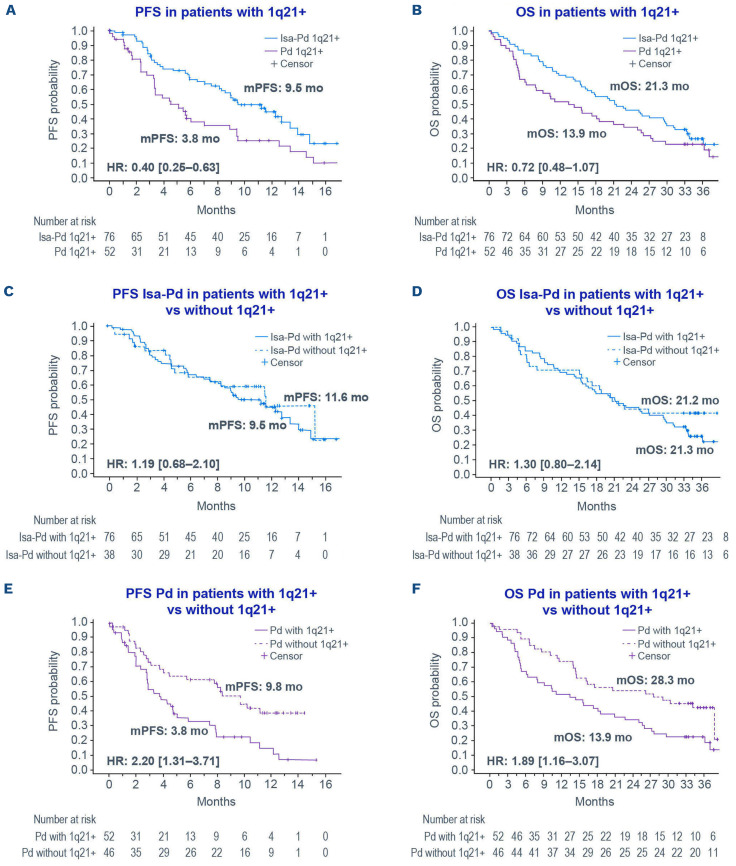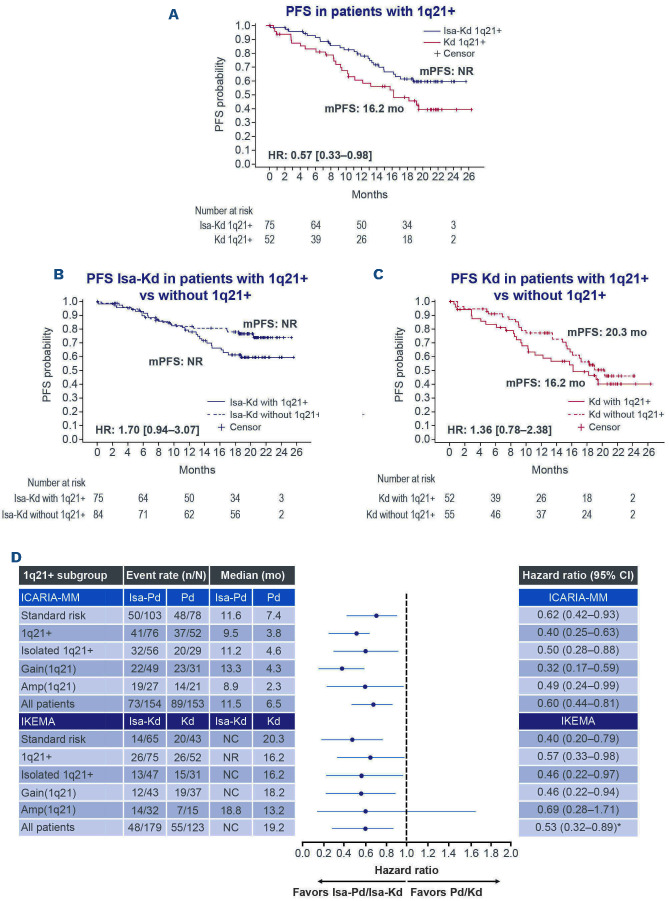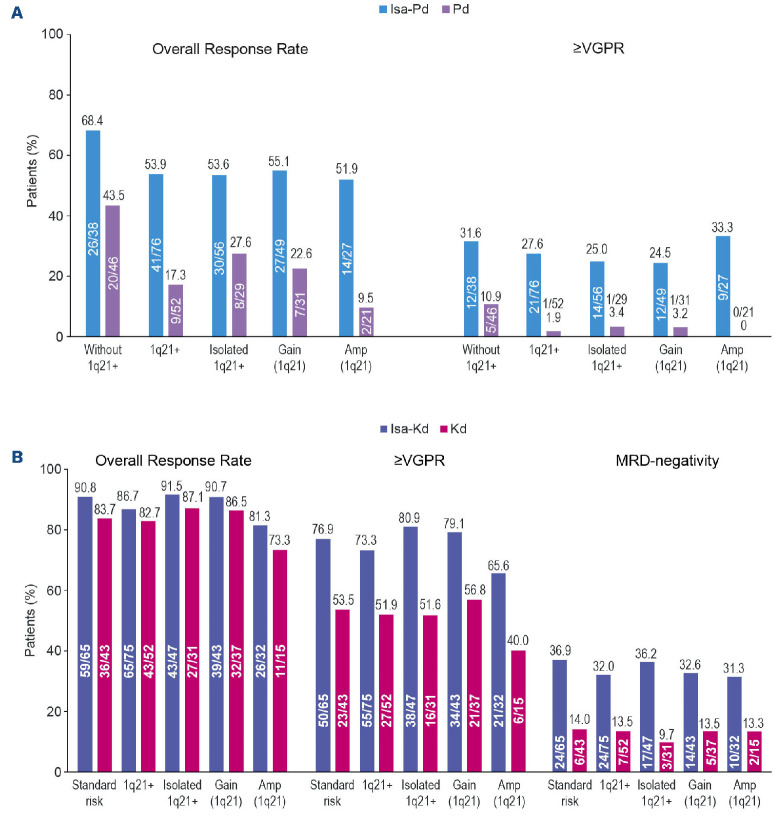Gain/amplification of 1q21, referred to as 1q21+ in this letter, is one of the most common chromosomal abnormalities in multiple myeloma (MM),1 being detected in approximately 40% of patients at diagnosis.1-3 The number of MM cells with 1q21+ and the number of copies of 1q21+ increases as the disease progresses.2 Furthermore, its negative impact on prognosis suggests that 1q21+ is involved in the pathophysiology of disease progression and resistance to MM treatment.1 The 1q21+ abnormality is defined as gain of 1q21 (gain[1q21], 3 copies) and amplification of 1q21 (amp[1q21], ≥4 copies).2,3 Co-existence of certain high-risk chromosomal abnormalities is common and further worsens the prognosis for patients with 1q21+.2 In the phase III studies ICARIA-MM and IKEMA, the addition of the anti-CD38 monoclonal antibody isatuximab (Isa) to the backbone of pomalidomide–dexamethasone (Pd) or carfilzomib–dexamethasone (Kd), respectively, improved progression-free survival (PFS) among patients with relapsed/refractory MM,4,5 and subgroup analyses suggested benefit among patients with 1q21+.6,7 The current analyses examine four subgroups of patients from ICARIA-MM and IKEMA: 1q21+ (≥3 copies with or without high-risk chromosomal abnormalities), isolated 1q21+ (≥3 copies without high-risk chromosomal abnormalities), gain(1q21) (3 copies with or without high-risk chromosomal abnormalities), and amp(1q21) (≥4 copies with or without high-risk chromosomal abnormalities). The analyses show a clear benefit of Isa-based combinations in 1q21+ disease.
Full methodological details of the randomized, open-label, phase III ICARIA-MM (ClinicalTrials.gov, identifier NCT02990338) and IKEMA (ClinicalTrials.gov, identifier NCT03275285) studies were previously described.4,5 The primary endpoint in both trials was PFS, as assessed by an independent response committee. Secondary end-points included overall survival (OS) and overall response rate, assessed according to International Myeloma Working Group response criteria.8 For each study (Isa-Pd versus Pd or Isa-Kd versus Kd), within- and between-treatment group efficacy evaluations were conducted in the following populations: patients with versus without 1q21+; patients with versus without isolated 1q21+; patients with versus without gain(1q21); and patients with versus without amp(1q21). The presence of 1q21+ was evaluated using CD138+ plasma cells and a 30% cutoff. Cutoffs for high-risk chromosomal abnormalities were 50% for del(17p) and 30% for t(4;14) and t(14;16). For both PFS and OS, estimates of the median and corresponding confidence interval (CI) were determined using the Kaplan-Meier method. Hazard ratios (HR) were determined using an unstratified Cox regression model, with terms for the factor, treatment, and their interaction. The test for the interaction was performed at the 10% α level.
Of the 307 and 302 patients randomized in ICARIA-MM and IKEMA, respectively, cytogenetic risk was assessable by the central laboratory in 241 (78.5%) and 265 (87.7%) patients. Of the intention-to-treat populations, 49.4% (n=76/154; Isa-Pd) and 34.0% (n=52/153; Pd) had 1q21+ in ICARIA-MM, whereas 41.9% (n=75/179; Isa-Kd) and 42.3% (n=52/123; Kd) had 1q21+ in IKEMA. Patient-related and clinical characteristics at baseline were balanced across treatment arms with respect to 1q21+ status regardless of treatment arm (Online Supplementary Table S1).
The addition of Isa to Pd improved PFS and OS for patients with 1q21+ compared with the Pd groups (Figure 1). Patients with 1q21+ had a median PFS of 9.5 versus 3.8 months in the Isa-Pd versus Pd groups (HR=0.40, 95% CI: 0.25–0.63) (Figure 1A). The median OS for patients with 1q21+ was 21.3 versus 13.9 months in the Isa-Pd versus Pd groups (HR=0.72, 95% CI: 0.48–1.07) (Figure 1B). The median PFS for patients in the Isa-Pd group with versus without 1q21+ was 9.5 versus 11.6 months (Figure 1C) and the median OS for patients in the Isa-Pd group with versus without 1q21+ was 21.3 versus 21.2 months (Figure 1D). This compared with a median PFS of 3.8 months for those with 1q21+ versus 9.8 months for patients without 1q21+ in the Pd group (Figure 1E), and a median OS of 13.9 months for those with 1q21+ versus 28.3 months without 1q21+ in the Pd group (Figure 1F). The PFS and OS curves in the Isa-Pd group for patients with 1q21+ overlap with those for patients without 1q21+ (Figure 1C, D). In comparison, the PFS and OS curves in the Pd group for patients with 1q21+ versus those without 1q21+ clearly separate, with patients with 1q21+ having shorter PFS and OS (Figure 1E, F). We also performed outcome analyses for additional subgroups of patients from ICARIA-MM with isolated 1q21+, gain(1q21), and amp(1q21). A clear benefit of Isa addition was observed in all subgroups of patients, irrespective of high-risk chromosomal abnormalities. Results are available in Online Supplementary Figure S1.
In patients with 1q21+ the addition of Isa to Kd improved PFS compared to that achieved with Kd alone (Figure 2). The median PFS in patients with 1q21+ who received Isa-
Figure 1.
Survival outcomes in patients with relapsed/refractory multiple myeloma in the ICARIA-MM study according to treatment received and 1q21+ status. (A-F) Kaplan-Meier estimates of progression-free survival and overall survival from the ICARIA-MM study in the subgroup of patients with 1q21+ treated with isatuximab (Isa) plus pomalidomide–dexamethasone (Pd) versus Pd (A, B), Isa-Pd with 1q21+ versus Isa-Pd without 1q21+ (C, D), and Pd with 1q21+ versus Pd without 1q21+ (E, F). Progression-free survival was defined as the time from randomization to first documentation of progressive disease before initiation of anti-myeloma therapy or death from any cause, whichever came first. Progression-free survival data were analyzed as per the ICARIA-MM primary analysis cutoff date (October 11, 2018). Overall survival data were analyzed at the second interim cutoff date (October 1, 2020). Efficacy analyses were performed on the intention-to-treat population and summarized by assigned treatment. Confidence intervals are 95% for all Kaplan-Meier plots. 1q21+ definition: ≥3 copies, 30% cutoff, with or without high-risk chromosomal abnormalities. PFS: progression-free survival; mPFS: median progression-free survival; mo: months; HR: hazard ratio; OS: overall survival; mOS: median overall survival.
Kd was not reached versus 16.2 months in patients who received Kd (HR=0.57, 95% CI: 0.33–0.98) (Figure 2A). The median PFS was not reached by both the Isa-Kd patients with 1q21+ and the Isa-Kd patients without 1q21+, and the curves overlapped until approximately 11 months (Figure 2B). The median PFS of patients treated with Kd was 16.2 months for those with 1q21+ versus 20.3 months for patients without 1q21+, and the curves separated early following the initiation of treatment (Figure 2C). Additional outcomes for subgroups of patients from IKEMA with isolated 1q21+, gain(1q21), and amp(1q21) are available in Online Supplementary Figure S2.
Figure 2.
Progression-free survival in patients with relapsed/refractory multiple myeloma according to treatment received and 1q21+ status. (A-C) Kaplan-Meier estimates of progression-free survival from the IKEMA study in the subgroup of patients with 1q21+ in the group treated with isatuximab (Isa) plus carfilzomib–dexamethasone (Kd) versus Kd (A), Isa-Kd with 1q21+ versus Isa-Kd without 1q21+ (B), and Kd with 1q21+ versus Kd without 1q21+ (C). (D) Progression-free survival risk across treatment arms in the ICARIA-MM and IKEMA studies according to 1q21+ status. *99% confidence intervals were stratified on number of prior lines of therapy (1 versus >1) and Revised International Staging System stage (I or II versus III versus not classified) according to interactive response technology. Progression-free survival was defined as the time from randomization to first documentation of progressive disease before initiation of anti-myeloma therapy or death from any cause, whichever came first. Progression-free survival was analyzed as per the IKEMA primary analysis cutoff date (February 7, 2020). Efficacy analyses were performed on the intention-to-treat population and summarized by assigned treatment. Confidence intervals are 95% for all Kaplan-Meier plots and forest plots, except where otherwise indicated. 1q21+ definition: ≥3 copies, 30% cutoff, with or without high-risk chromosomal abnormalities. CI: confidence interval; HR: hazard ratio; Isa: isatuximab; mo: months; mPFS: median progression-free survival; NC: not calculable; NR: not reached; PFS: progression-free survival.
Figure 2D shows forest plots for PFS from both trials. Hazard ratios for all subgroups related to 1q21+ favored Isa-Pd over Pd (range, 0.32–0.50) and Isa-Kd over Kd (range, 0.46–0.69). Apart from the Isa-Kd versus Kd subgroup with amp(1q21), the upper bounds of the 95% CI did not cross unity for the different subgroups related to 1q21+. In ICARIA-MM, the addition of Isa to Pd led to improved depth of response in the subgroups with 1q21+, isolated 1q21+, gain(1q21), and amp(1q21) (Figure 3A). In IKEMA, the depth of response in patients with 1q21+, isolated 1q21+, gain(1q21), and amp(1q21) was better in the Isa-Kd group than in the Kd group, with higher rates of response, very good partial response or better, and minimal residual disease negativity (Figure 3B). Safety data across subgroups were consistent with the overall treatment population from ICARIA-MM and IKEMA (data not shown).4,5 Two independent phase III studies have now shown that the addition of Isa to a standard-of-care backbone (Pd or Kd) improves PFS to the same extent in patients with 1q21+, gain(1q21), and amp(1q21). In ICARIA-MM, the PFS curves in the Isa arm appear to be overlapping for patients with and without 1q21+. In IKEMA, the PFS curves in the Isa arm appear to be overlapping in the first 11 months. Depth of response is consistently similar for patients with or without 1q21+. In both studies, the PFS curves in the standard-of-care arms were inferior for patients with 1q21+ compared to those without 1q21+. This was particularly apparent in patients who received Pd, but less so for patients who received Kd; this confirms a recent observation that carfilzomib-based treatment (carfilzomib-lenalidomide-dexamethasone with or without stem cell transplantation) is beneficial for patients with 1q21+.9,10 Compared to the benefits observed with Isa treatment in patients with 1q21+, limited information is available for daratumumab. In a single, prospective, observational study, the prognostic impact of 1q21+ and gene expression profiling (GEP70) risk score at initial presentation and prior to daratumumab therapy were assessed in 81 patients with relapsed/refractory MM.11 Daratumumab was given in combination therapy to 80.5% of patients (with pomalidomide in 58% of these patients) and as a single agent to 19.5% of patients. The median PFS was 0.5 years in the 1q21+ cohort (versus 2.1 years in patients without 1q21+), whereas the median OS was 0.9 years in the 1q21+ cohort (versus not reached in patients without 1q21+). Multivariate analyses revealed that GEP70 score and 1q21+ status at initial presentation were independently associated with inferior PFS (P<0.05), whereas only GEP70 score was statistically associated with poor OS (P<0.05); the presence of 1q21+ showed a tendency to be associated with poor OS (P=0.06). According to the authors, the poor outcome among patients with relapsed/refractory MM and 1q21+ receiving daratumumab-based therapy may be associated with daratumumab-mediated induction of complement-dependent cytotoxicity, which could be mediated by up-regulation of complement protein CD55, whose gene is localized to 1q32.2.11 A recent study found no prognostic benefit of daratumumab-based therapy on the outcome of newly diagnosed MM patients with 1q21+ in a real-world setting, although the study had limitations because of its relatively small sample size and its retrospective, singlecenter nature.12
Overexpression of complement regulatory proteins CD55 and CD59 has been implicated in daratumumab resistance.13 Interestingly, the gene encoding CD55 is localized to 1q32.2, and overexpression of CD55 has been suggested to contribute to daratumumab resistance in 1q21+ patients.11 In contrast to daratumumab, the antitumor activity of Isa relies more heavily on antibody-dependent cellular cytotoxicity than complement-dependent cytotoxicity.14,15 It is worth noting that the CD55 gene is located outside of the 1q21 band, and how its upregulation could be associated with 1q21+ requires further investigation.
The beneficial outcomes associated with Isa-based combination therapy in patients with 1q21+, observed in ICA-RIA-MM and IKEMA, suggest that such therapy can ease the negative prognostic impact of 1q21+ in patients with relapsed/refractory MM. In conclusion, Isa-Pd and Isa-Kd represent important treatment options for the difficultto-treat subgroup of patients with relapsed/refractory MM and 1q21+.
Figure 3.
Response rates in patients with relapsed/refractory multiple myeloma according to treatment and 1q21+ status. (A) Overall response and very good partial response or better in each treatment arm of ICARIA-MM, and (B) overall response, very good partial response or better, and minimal residual disease negativity rate in each treatment arm of IKEMA, according to 1q21+ status. Minimal residual disease negativity was assessed by next-generation sequencing at 10-5 sensitivity. 1q21+ definition: ≥3 copies, 30% cutoff, with or without high-risk chromosomal abnormalities. Isolated 1q21+ definition: ≥3 copies, 30% cutoff, without high-risk chromosomal abnormalities. Gain(1q21) definition: 3 copies, 30% cutoff, with or without high-risk chromosomal abnormalities. Amp(1q21) definition: ≥4 copies, 30% cutoff, with or without high-risk chromosomal abnormalities. Amp: amplification; d: dexamethasone; Isa: isatuximab; K: carfilzomib; MRD: minimal residual disease; P: pomalidomide; VGPR: very good partial response.
Supplementary Material
Funding Statement
Funding: Sanofi funded this sub-analysis of the ICARIA-MM and IKEMA studies. Medical writing support was provided by John Clarke, PhD, and Camile Semighini Grubor, PhD, on behalf of Elevate Medical Affairs, contracted by Sanofi for publication support services.
References
- 1.Bisht K, Walker B, Kumar SK, et al. Chromosomal 1q21 abnormalities in multiple myeloma: a review of translational, clinical research, and therapeutic strategies. Expert Rev Hematol. 2021;14(12):1099-1114. [DOI] [PubMed] [Google Scholar]
- 2.Hanamura I. Gain/amplification of chromosome arm 1q21 in multiple myeloma. Cancers (Basel). 2021;13(2):256. [DOI] [PMC free article] [PubMed] [Google Scholar]
- 3.Hanamura I, Stewart JP, Huang Y, et al. Frequent gain of chromosome band 1q21 in plasma-cell dyscrasias detected by fluorescence in situ hybridization: incidence increases from MGUS to relapsed myeloma and is related to prognosis and disease progression following tandem stem-cell transplantation. Blood. 2006;108(5):1724-1732. [DOI] [PMC free article] [PubMed] [Google Scholar]
- 4.Attal M, Richardson PG, Rajkumar SV, et al. Isatuximab plus pomalidomide and low-dose dexamethasone versus pomalidomide and low-dose dexamethasone in patients with relapsed and refractory multiple myeloma (ICARIA-MM): a randomised, multicentre, open-label, phase 3 study. Lancet. 2019;394(10214):2096-2107. [DOI] [PubMed] [Google Scholar]
- 5.Moreau P, Dimopoulos MA, Mikhael J, et al. Isatuximab, carfilzomib, and dexamethasone in relapsed multiple myeloma (IKEMA): a multicentre, open-label, randomised phase 3 trial. Lancet. 2021;397(10292):2361-2371. [DOI] [PubMed] [Google Scholar]
- 6.Harrison SJ, Perrot A, Alegre A, et al. Subgroup analysis of ICARIA-MM study in relapsed/refractory multiple myeloma patients with high-risk cytogenetics. Br J Haematol. 2021;194(1):120-131. [DOI] [PMC free article] [PubMed] [Google Scholar]
- 7.Spicka I, Moreau P, Martin TG, et al. Isatuximab plus carfilzomib and dexamethasone in relapsed multiple myeloma patients with high-risk cytogenetics: IKEMA subgroup analysis. J Clin Oncol. 2021;39(s15):8042. [DOI] [PMC free article] [PubMed] [Google Scholar]
- 8.Rajkumar SV, Harousseau JL, Durie B, et al. Consensus recommendations for the uniform reporting of clinical trials: report of the International Myeloma Workshop Consensus Panel 1. Blood. 2011;117(18):4691-4695. [DOI] [PMC free article] [PubMed] [Google Scholar]
- 9.D'Agostino M, Ruggeri M, Aquino S, et al. Impact of gain and amplification of 1q in newly diagnosed multiple myeloma patients receiving carfilzomib-based treatment in the Forte trial. Blood. 2020;136(Suppl 1):38-40. [Google Scholar]
- 10.Mina R, Zamagni E, Fazio F, et al. Efficacy of carfilzomib-based induction/consolidation with or without autologous transplant and lenalidomide or carfilzomib-lenalidomide maintenance in high-risk patients in the Forte trial. HemaSphere. 2021;5(S2):46-47 (abstract S182). [Google Scholar]
- 11.Mohan M, Weinhold N, Schinke C, et al. Daratumumab in high-risk relapsed/refractory multiple myeloma patients: adverse effect of chromosome 1q21 gain/amplification and GEP70 status on outcome. Br J Haematol. 2020;189(1):67-71. [DOI] [PubMed] [Google Scholar]
- 12.Hu X, Wu CH, Cowan JM, Comenzo RL, Varga C. Outcomes of patients with multiple myeloma harboring chromosome 1q gain/amplification in the era of modern therapy. Ann Hematol. 2022;101(2):369-378. [DOI] [PubMed] [Google Scholar]
- 13.Nijhof IS, Casneuf T, van Velzen J, et al. CD38 expression and complement inhibitors affect response and resistance to daratumumab therapy in myeloma. Blood. 2016;128(7):959-970. [DOI] [PubMed] [Google Scholar]
- 14.van de Donk N, Richardson PG, Malavasi F. CD38 antibodies in multiple myeloma: back to the future. Blood. 2018;131(1):13-29. [DOI] [PubMed] [Google Scholar]
- 15.Zhu C, Song Z, Wang A, et al. Isatuximab acts through Fc-dependent, independent, and direct pathways to kill multiple myeloma cells. Front Immunol. 2020;11:1771. [DOI] [PMC free article] [PubMed] [Google Scholar]
Associated Data
This section collects any data citations, data availability statements, or supplementary materials included in this article.





